 With more people returning to offices and public spaces, it’s vital to ensure that washrooms are clean, hygienic and efficiently run facilities that people will be confident using. Paul Mulready, Marketing Manager of Northwood Hygiene Products Ltd looks at what washrooms can deliver
With more people returning to offices and public spaces, it’s vital to ensure that washrooms are clean, hygienic and efficiently run facilities that people will be confident using. Paul Mulready, Marketing Manager of Northwood Hygiene Products Ltd looks at what washrooms can deliver
With COVID now an accepted presence in our lives, our wellbeing remains important and businesses must ensure their buildings are kept as infection-free as possible. Providing clean and well-maintained premises is a challenge for facilities managers, placing greater pressure on them to ensure workplaces and public spaces resume normal activity safely.
From the moment people enter a building to when they visit the washroom, they expect to be reassured that all spaces are clean and safe. As well as providing an indication of the overall cleanliness of a building, washrooms play a fundamental role in helping to minimise the spread of viruses and germs.
However, it’s vital to ensure that washroom systems don’t just deliver optimal hygiene – they must be sustainable, robust and easy to maintain too. So, what do facilities managers need to consider when choosing their solution?
IS YOUR WASHROOM TIDY AND WELL-STOCKED?
Greater washroom use means that supplies of soap and towels deplete faster, requiring more frequent replenishment. Washrooms must be well-managed, with a continuous supply of soap and paper to allow visitors to wash and dry their hands and prevent them lingering in the washroom looking for supplies.
High-capacity units ensure a lasting supply and help to reduce frustrating run-outs for washroom users, as well as cutting down on the number of service visits required by operatives to restock.
Minimising the time that maintenance teams need to spend in washrooms is clearly important, so it’s helpful to have dispensers that are quick and easy to replenish. Cleaning operatives need to be able to see at a glance if paper dispensers need refilling, so it’s worth looking for ones with clear inspection windows that clearly show if they are nearly empty.
Lockable dispensers (ideally with keyed alike locks, so one key fits all units), deter vandalism and pilferage and reduce subsequent janitorial time to fix problems.
HOW CLEAN DOES YOUR WASHROOM LOOK?
People naturally want to feel confident that the washroom is being cleaned frequently, so it’s important to show that it is properly maintained by keeping it tidy and clearly displaying up-to-date details of cleaning schedules.
Dripping soap dispensers or bins overflowing with hand towels is unsightly, so it’s worth considering non-drip soap dispensers and high-capacity, controlled-use devices that restrict the use paper and prevent over usage.
It can help to enhance hygiene in the washroom by minimising touch points. Contactless paper dispensers where people only need to touch the paper they will use help to reduce the spread of germs.
WHAT ABOUT HAND DRYING?
Damp hands spread more germs, so it’s essential to look for hygienic hand drying solutions. Paper towels are an effective option as they dry hands more quickly and hygienically than air dryers and can be used by visitors as a barrier to avoid touching the door handle when exiting the washroom. Hand towel dispensers that dispense one sheet at a time in economical sheet lengths help to reduce waste and costs when consumption is likely to be higher.
More washroom footfall subjects the dispensers themselves to more wear and tear than usual, so units need to be durable as well as functional. FMs should seek out dispensers that are made from hardwearing materials that can withstand heavy use.
IS YOUR WASHROOM SUSTAINABLE?
Sustainability is a pressing issue, so FMs should consider how they can make their washrooms more environmentally-friendly. Does your current system use recycled materials where possible, with no unnecessary packaging? Is it designed to reduce over-use and create zero waste?
A solution like North Shore from Northwood for instance helps to deliver improved washroom hygiene standards, whilst also saving money and reducing waste. Designed to deliver zero waste and volume in use, it reduces the amount of deliveries of paper, lessens the quantity of packaging required and cuts the number of trucks on the road.
DO YOU HAVE HYGIENE REMINDERS IN YOUR WASHROOM?
For facilities managers, their role is more important than ever as they play a crucial part in helping to keep people safe in the coming months. Communication will play an important role in helping ensure washrooms users support that effort. For that reason, the use of posters on good handwashing and drying techniques are helpful reminders for people and convey that you are serious about hygiene.
Many people will still be nervous about entering workplaces and public spaces and it’s important for facilities managers to play their part by developing practical and sustainable washroom strategies that maximise hygiene and speed up time in the washroom, whilst also reducing the workload for cleaning operatives.





